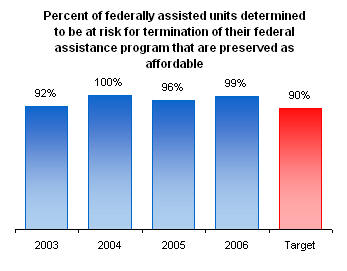 |
DEPARTMENT
RESULTS |
|
|
|
| |
|
Goal: End long-term
homelessness |
|
Why is this goal important?
Long-term homelessness is a breakdown in Minnesota’s social compact –
our vulnerable should not be left to the streets. Long-term homelessness, defined
as lacking a permanent place to live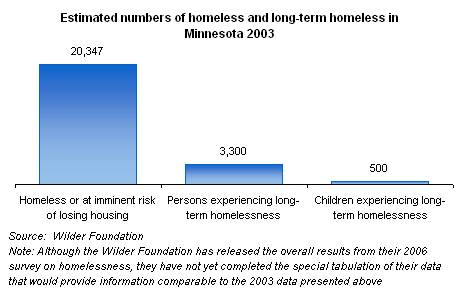 continuously for a year or more or at
least four times in the last three years, is associated with extreme
poverty, poor job skills, lack of education, and serious health conditions.
Beyond their individual issues, people experiencing long-term homelessness
also consume a disproportionate share of emergency room, shelter services,
crisis services and other social services. continuously for a year or more or at
least four times in the last three years, is associated with extreme
poverty, poor job skills, lack of education, and serious health conditions.
Beyond their individual issues, people experiencing long-term homelessness
also consume a disproportionate share of emergency room, shelter services,
crisis services and other social services.
People who have stable housing tend to use fewer crisis
health care services or the services they use are less expensive than when
they were homeless. Successfully housing people reduces social service costs
and provides opportunities for them to become economically self-sufficient,
fully participating members of the community.
|
|
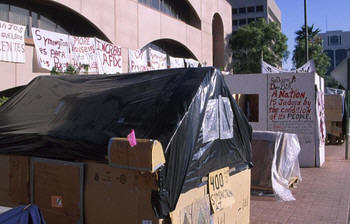 How
will this goal be accomplished? How
will this goal be accomplished?
Minnesota Housing, along with the Departments of Human Services and
Corrections, is a key partner in implementing the Business Plan on Ending
Long-Term Homelessness in Minnesota. Developed by a working group of public
and private stakeholders, the Business Plan aims to provide permanent
supportive housing to an additional 4,000 long-term homeless households by
2010. While the Business Plan originally estimated the cost of creating
these supportive housing opportunities at approximately $540 million over
seven years, funded through federal, state, and local government resources
as well as private contributions, a 2007 recalibration now estimates the
total costs over the lifetime of the plan to be $483 million.
Minnesota Housing funds the development, rehabilitation,
acquisition, or preservation of supportive housing through programs such as
the Housing Trust Fund, the Family Homeless Prevention and Assistance
Program, and the Ending Long-Term Homelessness Initiative Fund. The agency
also provides operating subsidies and rental assistance for permanent
supportive housing for people experiencing long-term homelessness.
|
|
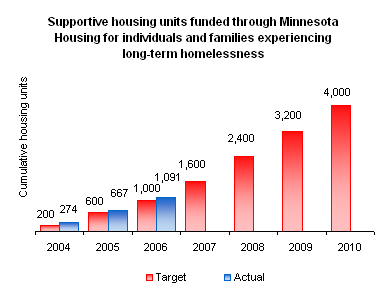
What is Minnesota Housing's progress to date?
As of December 2006, Minnesota Housing has funded 1,091 units of
supportive housing opportunities for people experiencing long-term
homelessness. Compared to the Business Plan’s goal of 1,000, Minnesota
Housing is 9 percent ahead of the target and 27 percent of the way toward
the 2010 goal of 4,000 housing units.
 Learn more at:
http://www.mhfa.state.mn.us/multifamily/LTH.htm
Learn more at:
http://www.mhfa.state.mn.us/multifamily/LTH.htm |
|
|
|
Goal: Increase minority homeownership |
|
Why is this goal important?
Homeownership is a principal element of the
American dream. For most Americans, homeownership is the most primary means
of wealth accumulation, and national and state policies have long encouraged
homeownership because of its impact on strengthening families and building
communities. Homeowners demonstrate higher levels of academic achievement,
and greater civic and voluntary involvement.
Minnesota’s overall homeownership rate is the highest in the nation at 75.8
percent. However, the overall rate for communities of color and/or Hispanic
ethnicity in Minnesota is significantly lower than the rate for white
Minnesotans. This homeownership gap stymies the American dream and prevents
wealth creation for households of color and/or Hispanic ethnicity.
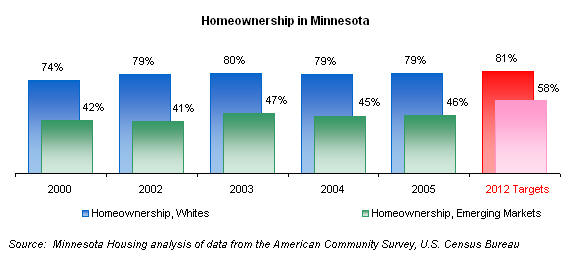
Minnesota Housing estimates that the
homeownership gap between white-headed households and households of color
and/or Hispanic ethnicity in 2005 was 33 percentage points, placing
Minnesota in the top ten states for the largest homeownership gap. |
| |
|
How will this goal be accomplished?
Minnesota Housing, along with the Federal Reserve Bank of Minneapolis and
the Fannie Mae Minnesota Community Business Office, convened the Emerging
Markets Homeownership Initiative (EMHI). In 2005, EMHI worked with the
homeownership industry to develop a detailed business plan to increase
homeownership in Minnesota’s emerging markets. Representing the input of
over 50 stakeholders, the business plan identifies twelve strategies
targeted to emerging markets that will:
 enhance trust in the home buying
process (e.g., recruit diverse homeownership
enhance trust in the home buying
process (e.g., recruit diverse homeownership
in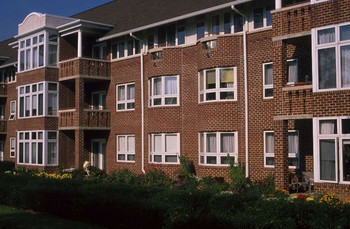 dustry
professionals); dustry
professionals);
 expand outreach (e.g., develop
culturally-
expand outreach (e.g., develop
culturally-
sensitive homebuyer training); and
 grow product innovations (e.g.,
expand
grow product innovations (e.g.,
expand
culturally-sensitive mortgage products and
underwriting processes)
The EMHI Initiative has been incorporated
as an independent 501(c)3 nonprofit organization. Work continues to convene
representatives from leading financial institutions, real estate
organizations, trade associations, and diverse community organizations to
develop pilot implementation of the EMHI business plan strategies.
In early 2006, Minnesota Housing implemented significant changes to some
first-time homebuyer programs to better target the emerging markets
population.
|
|
What
is Minnesota Housing's progress to date?
Minnesota Housing has increased its percentage of first-time home buyers
from communities of co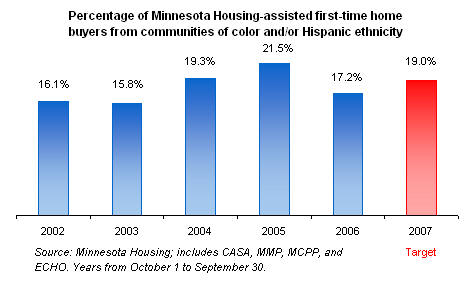 lor and/or Hispanic ethnicity from less than 16
percent in FY 2003 to nearly 22 percent in FY 2005. Actual performance in FY
2006 slipped to 17 percent as a result of organizational issues with one key
lending partner. The agency estimates that 17 percent of households
estimated to be eligible for Minnesota Housing assistance are from
communities of color and/or Hispanic ethnicity. lor and/or Hispanic ethnicity from less than 16
percent in FY 2003 to nearly 22 percent in FY 2005. Actual performance in FY
2006 slipped to 17 percent as a result of organizational issues with one key
lending partner. The agency estimates that 17 percent of households
estimated to be eligible for Minnesota Housing assistance are from
communities of color and/or Hispanic ethnicity.
 Learn more at:
http://www.mhfa.state.mn.us/homes/EMHI.htm
Learn more at:
http://www.mhfa.state.mn.us/homes/EMHI.htm |
| |
|
Goal:
Preserve strategically the existing affordable housing stock |
|
Why is this goal
important?
Much of our state’s existing single-family and multifamily affordable
housing stock is at risk of deteriorating, and replacement is
cost-prohibitive. No affordable housing development can produce housing that
is as affordable to residents as maintaining the existing stock of federally
assisted rental housing or bringing substandard single-family housing into
service. Preserving this housing costs substantially less per unit than new
construction and leverages federal rent or mortgage subsidies well into the
future.
Currently, there are approximately
100,000 units of multifamily rental housing that have received or currently
receive federal or state assistance to keep them affordable. Approximately
170,000 additional units provide affordable rental housing opportunities
without direct assistance. As these rental properties age or as subsidy
contracts and regulatory agreements expire, these units may convert to
unaffordable market rate housing or simply be lost due to deterioration.
Preservation helps eliminate the danger of housing becoming unaffordable for
low- and moderate- income households.
|
|
|
|
How will this goal be accomplished?
Minnesota Housing strategies focus on preserving the affordability of
multifamily housing and on rehabilitating and improving aging single-family
homes. The agency emphasizes opportunities for community partnerships and
leveraging activities to maximize the continual use of Minnesota’s existing
housing inventory.
To preserve affordable rental housing, Minnesota Housing strategies include
changes to underlying financing, operating subsidies to owners, direct
subsidies to tenants, or simply through the existing rent structure. The
agency also monitors situations where federal assistance for existing rental
housing is in jeopardy and examines whether using state funds to preserve
this housing is appropriate, necessary and cost-effective. Minnesota Housing
coordinates its preservation efforts with its funding partners – the Family
Housing Fund, the Greater Minnesota Housing Fund, the U.S. Department of
Housing and Urban Development, Rural Development (U.S. Department of
Agriculture), and the cities of Minneapolis and St. Paul.
Home improvement programs preserve Minnesota's existing single-family
housing stock with property rehabilitation, weatherization, remodeling and
housing recycling activities. Delivered through an extensive network of
partners and lenders, these programs reach a broad range of household
incomes and properties.
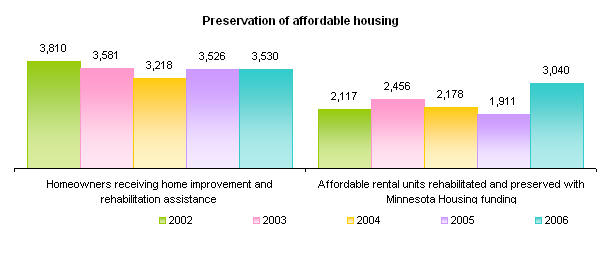
What
is Minnesota Housing's progress to date?
In FY 2006, Minnesota Housing disbursed funds to rehabilitate, improve,
or preserve the affordability of over 6,500 units of existing single and
multifamily housing. This activity includes $15.7 million to preserve more
than 800 units of existing subsidized rental housing through Affordable
Rental Investment Fund-Preservation (PARIF) and $4.1 million to rehabilitate
nearly 400 units of housing occupied by low-income homeowners through the
Rehabilitation Loan Program. Loans on a few large housing developments
closed in 2006, leading to the 50 percent increase in affordable rental
units rehabilitated and preserved.
Preservation of existing housing remains the most
cost-effective means of providing affordable housing. Each dollar of state
spending under various Agency programs, since 1998, has leveraged $5.30 of
federal investment in affordable rental housing.
 Learn more at:
Learn more at:
http://www.mhfa.state.mn.us/homes/homes_improvement.htm
http://www.mhfa.state.mn.us/multifamily/multifamily_preserving.htm
|
| |
|
Goal: Low-and-moderate income workers have affordable housing |
|
Why is this goal
important?
Families who pay more than 30 percent of their income for housing are
considered cost-burdened and may have difficulty affording necessities such
as food, clothing, transportation and medical care. The lack of affordable
housing is a significant hardship for low-income households preventing them
from meeting their other basic needs or saving for their household’s future.
By providing affordable housing to low- and moderate-income workers,
Minnesota Housing allows Minnesota’s workforce, the backbone of the state’s
economic growth and vitality, to focus their energies on their jobs, their
communities and their families.

By developing affordable housing in areas of the greatest employment growth,
Minnesota Housing supports efforts to decrease commuter times and reduce
traffic congestion in inter-regional corridors. Housing close to jobs also
minimizes household transportation costs, allowing households to spend more
on housing and other needs. |
| |
|
How will this goal be accomplished?
Minnesota Housing provides construction and permanent mortgage financing to
sponsors and developers of affordable rental housing, monthly rent
assistance vouchers to qualifying low-income households, and entry cost
assistance and permanent mortgage financing to qualifying first-time
homebuyers.

Minnesota Housing works to increase housing choices
for low- and moderate-income workers by collaborating
with employers, philanthropic organizations, local governments, nonprofits,
and other partners – including the Family Housing Fund, the Greater
Minnesota Housing Fund, and the Metropolitan Council – to provide greater
affordable housing opportunities. Selection guidelines for the Minnesota’s
Housing’s Economic Development and Housing Challenge Fund prioritize funding
proposals that locate housing close to areas of job growth, transit ways,
and transportation corridors or that include employer or local contributions
to increase the affordability of housing.
|
|
What is
Minnesota Housing's progress to date?
The changing climate of the private mortgage market has made
Minnesota Housing products once again more appealing to low- and
moderate-income borrowers. First-time mortgages have jumped to over 3,000 in
FY 2006 for the first time since 1997.
The median household income of first-time home-buyers assisted by the agency
has inched up to $37,440 or 55 percent of the area median family income
defined by the U.S. Department of Housing and Urban Development (HUD).
Stable from 2005, this compares to 47 percent in 2002. The median household
income of renters Minnesota Housing assists (excluding Section 8 rental
assistance) is $14,125 or 21 percent of the HUD area median income. This
compares to 28 percent in 2002 and 21 percent in 2003.
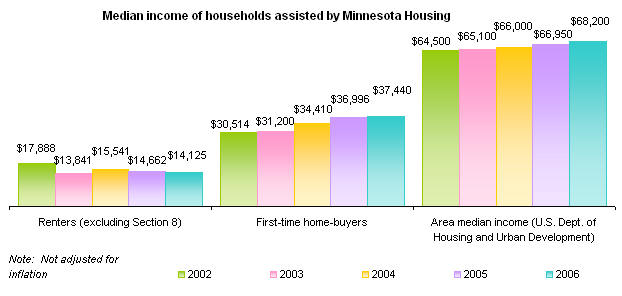
 Learn more at:
http://www.mhfa.state.mn.us/
Learn more at:
http://www.mhfa.state.mn.us/ |
| |
|
Goal: Establish Minnesota Housing as a housing partner of choice |
|
Why is this goal
important?
Minnesota Housing cannot achieve its goals independent of the
developers, local units of government, financial institutions, and community
organizations who partner with the agency and are often the face of agency
products to end consumers. Limited resources require redoubled efforts at
customer service, collaboration, and creativity.
|
|
How will this goal be accomplished?
Externally, Minnesota Housing has established the
Housing Resource Advisory Council as a forum for discussing how the agency’s
resources can complement our partners’ efforts to promote affordable
housing. The Council includes representatives from local government, housing
and redevelopment and community development authorities, philanthropic
organizations, local financial and technical assistance organizations, and
financial advisors. The exchange of information and ideas around economic
development, affordable housing and homelessness helps inform Minnesota
Housing’s funding decisions and facilitate coordination of activities and
funding requests at the local level.
Internally, the agency has implemented a Customer Service Initiative focused
on transforming internal business processes to improve the agency’s service
to customers. Key strategies of the Customer Service Initiative have
included enhancing the use of technology, reviewing the agency’s
regulatory/underwriting standards, seeking program consolidation and
simplification opportunities, and learning from other organizations through
“best practice” reviews. |
| |
|
What is Minnesota
Housing's progress to date?
For the last year, Minnesota Housing has focused on enhancing the use of
technology. The Single Family Mortgages Online System (SFMOS) is a web-based
business-to-business system implemented in April 2007. Lending partners can
access to the system through a web interface to qualify for affordable
housing loans for purchase by Minnesota Housing. SFMOS will result in
improved service and on-line access for lending partners to do business with
Minnesota Housing. The agency is also implementing a new underwriting system
for multifamily rental developments that will improve Minnesota Housing’s
capacity to maintain accurate data for reporting and program analysis.
Eventually this system will be integrated with a new web-based application
and web-based underwriting that will be made available to our business
partners.
 Learn more at:
Learn more at:
http://www.mhfa.state.mn.us/homes/SFMOS.htm
http://www.mhfa.state.mn.us/about/MF_CSinitiative.pdf
|
|
Some images © 2003 www.clipart.com |
|
Last update on
07/27/2007 |


 continuously for a year or more or at
least four times in the last three years, is associated with extreme
poverty, poor job skills, lack of education, and serious health conditions.
Beyond their individual issues, people experiencing long-term homelessness
also consume a disproportionate share of emergency room, shelter services,
crisis services and other social services.
continuously for a year or more or at
least four times in the last three years, is associated with extreme
poverty, poor job skills, lack of education, and serious health conditions.
Beyond their individual issues, people experiencing long-term homelessness
also consume a disproportionate share of emergency room, shelter services,
crisis services and other social services.



 dustry
professionals);
dustry
professionals); lor and/or Hispanic ethnicity from less than 16
percent in FY 2003 to nearly 22 percent in FY 2005. Actual performance in FY
2006 slipped to 17 percent as a result of organizational issues with one key
lending partner. The agency estimates that 17 percent of households
estimated to be eligible for Minnesota Housing assistance are from
communities of color and/or Hispanic ethnicity.
lor and/or Hispanic ethnicity from less than 16
percent in FY 2003 to nearly 22 percent in FY 2005. Actual performance in FY
2006 slipped to 17 percent as a result of organizational issues with one key
lending partner. The agency estimates that 17 percent of households
estimated to be eligible for Minnesota Housing assistance are from
communities of color and/or Hispanic ethnicity. 